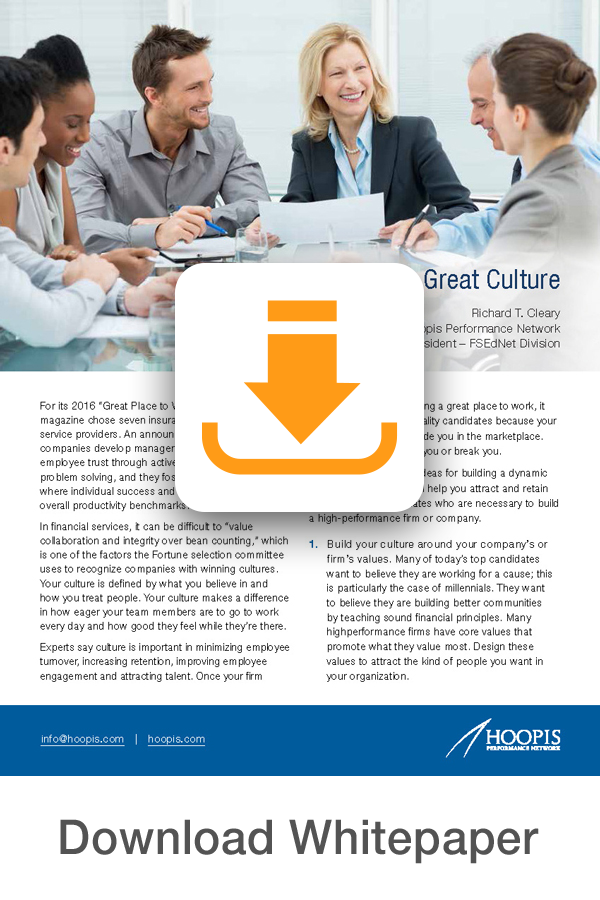How to Build a Great Culture

For its 2016 “Great Place to Work” rankings, Fortune magazine chose seven insurance and financial service providers. An announcement noted, “These companies develop managers and policies that build employee trust through active listening and creative problem solving, and they foster a workplace culture where individual success and performance trumps overall productivity benchmarks.”
In financial services, it can be difficult to “value collaboration and integrity over bean counting,” which is one of the factors the Fortune selection committee uses to recognize companies with winning cultures. Your culture is defined by what you believe in and how you treat people.
Your culture makes a difference in how eager your team members are to go to work every day and how good they feel while they’re there.
Experts say culture is important in minimizing employee turnover, increasing retention, improving employee engagement and attracting talent. Once your firm builds a reputation for being a great place to work, it helps you attract high-quality candidates because your reputation starts to precede you in the marketplace. Ultimately, that will make you or break you.
Here are some specific ideas for building a dynamic company culture that will help you attract and retain the high-quality associates who are necessary to build a high-performance firm or company.
- Build your culture around your company’s or firm’s values. Many of today’s top candidates want to believe they are working for a cause; this is particularly the case of millennials. They want to believe they are building better communities by teaching sound financial principles. Many highperformance firms have core values that promote what they value most. Design these values to attract the kind of people you want in your organization.
- Filter out candidates who don’t fit your culture. Occasionally, you may have candidates who say your core values are not for them. Although we read a lot about the importance of inclusion, and we never want to do things to make people feel uncomfortable, sometimes this is a sign that a person would be happier somewhere else. Part of being a high performer is to know who you are and to be authentic. Even the best firms are not a fit for everyone, but they want to attract like-minded individuals. Before posting your values, as well as your philosophy or mission, we suggest you get them approved by your home office.
- Support causes that are important to the people in your company or firm. Some firms take nominations from their associates and staff and get behind two or three worthwhile causes that galvanize the team. Updating the list on an annual basis gives you an opportunity to support different causes and involve more people who have various passions. Some great examples of how firms can support those causes are to have teams that participate in walks, bike rides, bowling tournaments and golfing for charity. You can enhance the camaraderie by having the participants wear team T-shirts or hats featuring your logo. This shows that your firm or company supports the cause. You can increase the visibility and fun for participants by posting photos from the event on your social media sites and website and also in your newsletter. Some firms allocate a day annually for team members to represent the firm by volunteering at a company-approved charitable event, or an event hosted by their favorite charity, without being required to take vacation time.
- Have “casual day” one day per month. Allow team members to wear casual clothing, even jeans, to work if they donate to the firm-approved charity. Although some people think this seems unprofessional and worry what visitors might think, you can post a sign in the reception area that says, “Please pardon our casual attire today. Some of our staff members have chosen to donate in support of (list the charity) to have this privilege.” An article in the Harvard Business Review stated that it is important to create a fun environment, but great corporate culture is more about a common sense of purpose and belief that “we are in this together.”
- Have fun at work. According to Fast Company, prioritizing fun in the workplace is essential to a company’s success. It boosts morale; lifts spirits; and creates a friendlier, happier and healthier environment for everyone. And some studies show that high-performance teams have fun while they are at work. Having fun often starts with the leaders not taking themselves too seriously. Everyone loves it when the boss has a good sense of humor and can take a fun jab or be self-deprecating. When the company celebrates, the leaders should not be working in their offices; that sends the message that their tasks are more important to them than enjoying the company of their team members. The leaders should be first to join in the karaoke or even to sing at a holiday party. They should wear the silly hats and participate in the activities. If the group is dancing, everyone will be more likely to join in when the leaders lead by example. If the leaders act as if they are above the rest, they send a message that their real goal is to check ‘have a fun event’ off their task list.
- Take opportunities to celebrate as often as possible. This is an excellent way to build morale. Some prominent examples are to recognize major holidays and birthdays. Larger firms may host monthly parties for everyone celebrating a birthday or company anniversary in a month. Still other companies may have an employee of the month who gets special recognition at a staff meeting, plus a gift card or a meal with the boss as thanks. Yet other firms will celebrate any month in which they hit or exceed a sales goal or top their performance from the same month the previous year.
- Say “thank you” in person, and often. As the leader, you can never say “thank you” enough, and people never tire of being acknowledged or shown they are valued and appreciated. Associates and staff alike live for encouragement and to be recognized when they do a great job. When they do well, shout it from the mountaintop! Make sure everyone knows when a team member gets a compliment. Here are some ways to share the news of your team members’ successes:
• If you receive an email acknowledging that a team associate did particularly well, send a copy to everyone in the company when you reply to the sender.
• Have a board where people post notes or emails commending the team.
• Read notes of praise in a staff meeting or firm meetings. This builds up team members in front of their peers and lets everyone know this type of great performance is a great way to get noticed and stand out. On the other hand, if you get a call or email about below-average performance, always handle them privately, so the team member will not be embarrassed publicly. One embarrassing incident that is publicized can cancel out many incidences of encouragement—it can even cause someone to quit. - Take time to show people you care. Stopping by someone’s desk to see how they are doing is a good investment of your day. If you know someone has a sick family member or loved one, ask how they are doing. As the leader, “You reap what you sow.” Leaders who say thanks and take the time to encourage people often are surprised to find out how much it meant to others, and they tend to receive notes or calls telling them how they impacted people’s lives and made a difference. There is a time in most people’s lives when this form of affirmation and encouragement may mean as much as, or even more than, the money they make. As we like to say, leadership is about influence, and taking the time to influence others positively can pay eternal dividends.
- Always be there in your team members’ times of need. Some firms are full of people who take the time to check on them when they are sick. Caring leaders take the time to attend weddings and funerals that are important to their key team members. As busy as people are today, few gestures will show your associates you care more about them than being there with them at critical times in their lives. While making the time may seem burdensome at times, the savings on lower turnover, higher retention and deeper relationships will be a great return on your time invested.
- Communicate the company’s or firm’s vision to all members of your team. Some high-performance teams have an annual staff meeting off-site that features team-building activities and fun. This is especially important when a firm has multiple locations because it gives people who are in different offices a chance to get to know each other. It lets them all feel part of something larger than just their location. It is also wise to have an annual update to the strategic plan, business plan or marketing plan the leader shares with the team annually. It is important to write the vision and make it plain. Then the team can run with it after they read it.
Building a company culture takes time, effort and consistency. But you can create a great culture in small ways. Do what you can each day, week and month to have happier, healthier, more engaged and loyal team members, and you will never regret any of the effort spent. When your team members are motivated and happy, your clients and potential recruits will notice, which will lead to success for the overall organization.
Consider Hoopis Performance Network for Training
To help build your culture, consider using our virtual training videos in your company, agency or firm. HPN brings you winning training for sales associates, and training for sales leaders. They can access training and information on their smartphones and tablets when they have spare time, learn at their own pace and customize their curriculum based on what interests them the most.



